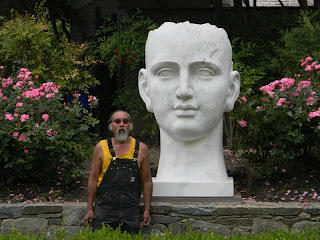In the spring of 2013, Fine Arts Specialists, was asked to lead the team that would de-install, pack and transport the monumental Mark Di Suvero sculpture:
“ Are Years What,” from the Hirshhorn Museum and Sculpture Garden to the San Francisco Museum of Modern Art:
http://en.wikipedia.org/wiki/Are_Years_What%3F_(for_Marianne_Moore). This was a great project for us and a reward after years specializing in handling sculpture.
Today is the last day of the exhibition and as it is Memorial day, I'm thinking about its return.This piece consists primarily of steel i-beams, the largest @ 40’ long and approx. 3,000 lbs. It is bolted together and required rigging/ crane, art handling crew/ carpenters and tractor trailer transport. Projects this scale requires perfect attention to detail. Troubleshooting begins at the start of the project. Since it would be a cross country journey, each piece of the sculpture had to be packed and each truckload tarped for protection.
Today is the last day of the exhibition and as it is Memorial day, I'm thinking about its return.This piece consists primarily of steel i-beams, the largest @ 40’ long and approx. 3,000 lbs. It is bolted together and required rigging/ crane, art handling crew/ carpenters and tractor trailer transport. Projects this scale requires perfect attention to detail. Troubleshooting begins at the start of the project. Since it would be a cross country journey, each piece of the sculpture had to be packed and each truckload tarped for protection.
To minimize costs, the sculpture would require the crane to be on-site for 1
day only. The day before we brought in a man-left and used it to loosen all the bolts so that we could minimize struggling with any bolt that was rusted or stubborn.



All work including the de-installation and the loading of the two trailers would have to be synchronized: as each part of the sculpture was unbolted and rigged, the tractors would have to be in position for the beams to be placed on the flatbeds. Each trailer was given a specific load plan because of the various sizes and shapes of the steel. The vertical, taller and shaped pieces would be placed on the single drop trailer to avoid over height permits and the 40’ long beams were placed on the conventional trailer. FAS would prepare most of the components to brace pack the pieces on the flatbeds ahead of time, only cutting 2x4’s as necessary on-site. A crate, approx. 4' x 4' x 8' was built to accommodate boxes of bolts, additional materials and misc. parts.


At the end of the day, the sculpture was de-installed completely and packed for transit. Everything arrived as scheduled and the artist, Mark Di Suvero with his team, re-installed it for the exhibition. Now that it is coming back, FAS is busy with the details of the sculpture coming home and we are grateful to be asked back to lead the team for its re-installation.
*photos provide by Joe Turpin
All work including the de-installation and the loading of the two trailers would have to be synchronized: as each part of the sculpture was unbolted and rigged, the tractors would have to be in position for the beams to be placed on the flatbeds. Each trailer was given a specific load plan because of the various sizes and shapes of the steel. The vertical, taller and shaped pieces would be placed on the single drop trailer to avoid over height permits and the 40’ long beams were placed on the conventional trailer. FAS would prepare most of the components to brace pack the pieces on the flatbeds ahead of time, only cutting 2x4’s as necessary on-site. A crate, approx. 4' x 4' x 8' was built to accommodate boxes of bolts, additional materials and misc. parts.
At the end of the day, the sculpture was de-installed completely and packed for transit. Everything arrived as scheduled and the artist, Mark Di Suvero with his team, re-installed it for the exhibition. Now that it is coming back, FAS is busy with the details of the sculpture coming home and we are grateful to be asked back to lead the team for its re-installation.
*photos provide by Joe Turpin






















